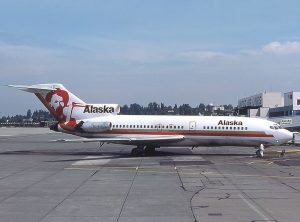 Sometimes, no matter how hard the airlines work to prevent it, things go wrong. Alaskan Airlines flight 1866, which became the first fatal jet airliner crash involving Alaska Airlines, was on a routine flight from Anchorage, Alaska to Seattle, Washington. The flight was scheduled to make intermediate stops at Cordova (CDV) and Yakutat (YAK/PAYA), which it made. It was also scheduled to stop in Juneau and Sitka before ending in Seattle. Things were going along smoothly when the flight landed at Yakutat at 11:07am and then departed at 11:35am for Juneau. The flight was operated by IFR (Instrument Flight Rules). At 09:13 Flight AS1866 departed from Anchorage and landed at 09:42 in Cordova. Something was not right with the luggage upon departing Cordova, so the flight landed at Yakutat at 11:07am. Problem solved the plane took off again at 11:35am headed for Juneau.
Sometimes, no matter how hard the airlines work to prevent it, things go wrong. Alaskan Airlines flight 1866, which became the first fatal jet airliner crash involving Alaska Airlines, was on a routine flight from Anchorage, Alaska to Seattle, Washington. The flight was scheduled to make intermediate stops at Cordova (CDV) and Yakutat (YAK/PAYA), which it made. It was also scheduled to stop in Juneau and Sitka before ending in Seattle. Things were going along smoothly when the flight landed at Yakutat at 11:07am and then departed at 11:35am for Juneau. The flight was operated by IFR (Instrument Flight Rules). At 09:13 Flight AS1866 departed from Anchorage and landed at 09:42 in Cordova. Something was not right with the luggage upon departing Cordova, so the flight landed at Yakutat at 11:07am. Problem solved the plane took off again at 11:35am headed for Juneau.
What happened next, sealed the fate of all 111 people onboard the flight. The date was September 4, 1971, and it was rainy day, with low clouds. Somehow, not everyone saw the situation in the same way, but the closest accounts to reality were the ones that had the plane flying into low clouds. According to the witnesses, it then flew straight into the Chilkat Mountains in Haines Borough, near Juneau, Alaska.
The aircraft was a Boeing 727-100 with U.S. registry N2969G. It was scheduled to stop in Juneau and Sitka before ending in Seattle. The aircraft was manufactured in 1966 as c/n 19304 and manufacturer’s serial number 287. It had accumulated 11,344 flight hours prior to the incident. Seven crew members were aboard, as well as 104 passengers. The plane was told to descend and maintain 12,000 feet, and the tower asked for confirmation that the level had been maintained during a maneuver to line up for landing. He was told that the flight level had been maintained, but in reality, it couldn’t have been. At 12:00, the dispatcher repeated the permit for passing the Howard point, and also estimated the approach time as 12:10. At 12:01 Flight 1866 reported passing 12 thousand feet. At 12:07, the plane was asked about its location relative to the landing course and the waiting pattern, and the controller reported that Flight 1866 had just entered the approach scheme and followed the Howard radio beacon, after which it gave permission to descend to pass the directional beacon at a height of no more than 9 thousand feet. The crew confirmed the permission to descend and reported on leaving a height of 12 thousand feet. At 12:08, the controller asked about the altitude, with the flight responding, “…leaving five thousand five… four thousand five hundred.” Flight 1866 was then instructed to contact the Juneau ATC Tower. The crew acknowledged the transmission and then changed to the tower frequency. The tower controller said, “Alaska 66, understand, ah, I didn’t, ah, copy the intergusts to 28, the altimeter now 29.47, time is 09 112. call section, landing Runway 8, the wind 0800 at 22 occasional us by Barlow”. The crew of Flight 1866 did not respond.
“According to the testimonies of three eyewitnesses, at this time there was a little rain, and the sky was covered with clouds. According to the meteorological service of the airport, at 11:56, the sky was partly cloudy with a lower boundary of 1,500 feet and up to 3,500 feet, and up to 7,500 feet – full clouds, light rain, visibility 15 miles. Also at 1:10 pm a pilot flying from Juneau to Sitka reported weather at 11:15 – overcast, light rain, lower cloud limit 1000 feet, upper – 3000 feet, visibility 10 miles, mountain tops and passes closed. Two witnesses who were in the region of the Chilkat Mountains stated that they heard a low-flying aircraft, but  could not see it because of low visibility, which they estimated at 55-65 meters. The sound of the engines was normal. Then after a minute there was an explosion. The third witness saw a plane that disappeared into the clouds, but then did not hear any sounds. At 12:15, aircraft struck the eastern slope of a canyon in the Chilkat Range of the Tongass National Forest at the 2500-foot level, 22 miles west of Juneau. The aircraft exploded on impact.” When the crew stopped responding, at 12:23, an immediate search for Flight 1866 began. A few hours later, the wreckage of the aircraft was found on the eastern slope of the Chilkat ridge at 21.3 miles west of Juneau airport. There were no survivors.
could not see it because of low visibility, which they estimated at 55-65 meters. The sound of the engines was normal. Then after a minute there was an explosion. The third witness saw a plane that disappeared into the clouds, but then did not hear any sounds. At 12:15, aircraft struck the eastern slope of a canyon in the Chilkat Range of the Tongass National Forest at the 2500-foot level, 22 miles west of Juneau. The aircraft exploded on impact.” When the crew stopped responding, at 12:23, an immediate search for Flight 1866 began. A few hours later, the wreckage of the aircraft was found on the eastern slope of the Chilkat ridge at 21.3 miles west of Juneau airport. There were no survivors.


One Response to Fatal Flight